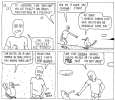
MAKING MY OWN COMICS, PART FOUR!
Making Comics, Part One
Making Comics, Part Two
Making Comics, Part Three
Making Comics, Part Four
Making Comics, Part Five: Motion Comics
Time to start making my own comics, by my self. Everything you see on these pages is an original work, copyright me, Sam Battin.
While I was putzing around the house I decided to show you just how easy it is to add dialog ballons to comics with Manga Studio 5 Ex. I uploaded the video below to YouTube, so please watch and enjoy! You also get a sneak peek at page three of my new comic!
There you have it! A page of dialog balloons in under ten minutes.
When I compare this to how I used to make word balloons, with the Aames tool, it's so much easier that I start shaking with relief and pride. I will conced the point that the hand-drawn lettering conveys more of a (for lack of a better word) "soul" than the computer but to this I reply:
I am one man, working alone. I am forty five. I do not have a ton of time to make these comics and the measure of my success is how much I produce. I can take ten minutes to letter a page with a computer or I can take two hours to letter a page by hand.
Below is an example of hand-drawn lettering from Goony, the Rather Foolish Bird:

|
Is it easy to read? Yeah, I think so. I can read it okay. There's a slight quiver in the lines forming the words that suggests a tightly-wound personality. Also, because it's distinctive, it adds to the feel of the world that Goony and Phil inhabit. Also it looks really natural when I use different-sized words.
Below is a set of dialog balloons rendered with Manga Studio 5.

|
The placement of the balloons is pretty natural, and it's easy to have the balloon tail point at whatever I want. If I decide to revise the dialog, or relocate the balloons, there is no white-out involved at all. So maybe when you're doing this by hand, you have to think harder about what exactly it is you want, and that thought translates into a more believable product. I can see a certain assembly line aspect to these word balloons, but I get benefits from Manga Studio that aren't immediately obvious.
First, as I mentioned, there's the time saved. Next, for something like talking on the phone, Manga Studio makes it easy to put in dialog balloons with pointy edges that are evenly spaced. This loooks more "professional" and also the reader doesn't have to spend any time trying to figure out what the dialog balloon represents; they know immediately he's talking on the phone. Actually they can probably figure that out from the picture, but still.
In addition, it's easy to figure out the best way to place the balloons and the tails so it's clear who's speaking and also so that I'm not covering up any important aspects of the art in the panel. For this, I like the "rule" that you should try to leave the top third of the panel open, or mostly blank, as a place for word balloons. I like the rule enough to use it, but I should break it more often than I do. Bringing the balloon into the panel makes the words more a part of the action, rather than rising above it.
And that's what I think about all that.
NEXT: Go read Making Comic Books Part Five or go back and read Making Comic Books Part Three!

